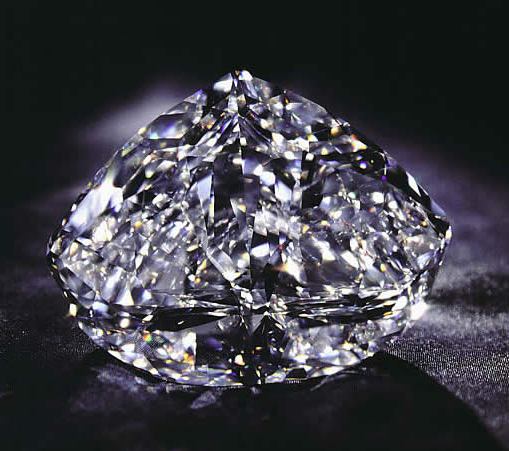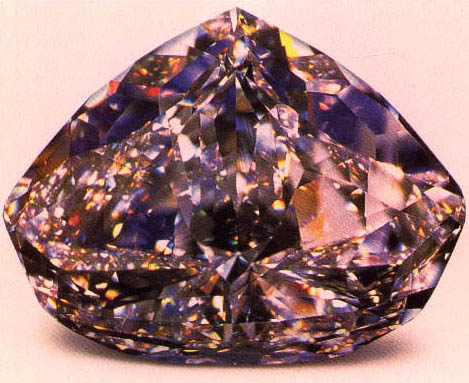Centenary Diamond
Origin of Name
The Centenary diamond gets its name from the centenary of the De Beers Consolidated Mines Ltd. celebrated on March 11, 1988. The Centenary rough diamond was actually discovered on July 17, 1986, at the Premier diamond mines, but all those involved in the discovery were sworn to silence. The closely guarded secret of the De Beers Mining Company was unveiled to the world only on March 11, 1988, at a special banquet held to mark the centenary, by the Chairman Mr. Julian Oglivie Thompson, who christened the stone the "Centenary Diamond".
Characteristics of the DiamondThe Centenary diamond is a 273.85-carat, D-color diamond with a modified heart-shape. The unique feature of the stone is it's exceptional clarity, and the stone has been graded as internally flawless (IF). The dimensions of the diamond are 50.50 x 39.90 x 24.55 mm. The stone has a total of 247 facets, 164 on the crown and the pavilion, and 83 around the girdle. The Centenary diamond is said to be the largest, faceted, D-color, flawless diamond in the world. It is also the 3rd largest, faceted, D-color diamond in the world, and overall the 5th largest faceted diamond in the world. See table below and the rank order list of famous diamonds on a different web page.
List of famous D-color diamonds over 100 carats in weight
S/N | Name | Carat Weight | Shape/Cut |
| 1 | Cullinan I | 530.20 | pear |
| 2 | CullinanII | 317.40 | cushion |
| 3 | Centenary | 273.85 | modified heart |
| 4 | Jubilee | 245.35 | cushion |
| 5 | Millennium Star | 203.04 | pear |
| 6 | La Luna | 200.07 | heart |
| 7 | Orlov | 189.62 | rose |
| 8 | Jacob-Victoria | 184.50 | oval |
| 9 | Regent | 140.64 | cushion |
| 10 | Paragon | 137.82 | 7-sided |
| 11 | Premier Rose | 137.02 | pear |
| 12 | Queen of Holland | 135.92 | cushion |
| 13 | Zale Light of Peace | 130.27 | Pear |
| 14 | Niarchos | 128.25 | Pear |
| 15 | Portuguese | 127.02 | asscher |
| 16 | Jonker | 125.35 | emerald |
| 17 | Al-Nader | 115.83 | pear |
| 18 | Taj-i-Mah | 115.06 | moghul |
| 19 | Edna Star | 115.00 | emerald |
| 20 | Koh-i-Nur | 108.93 | oval |
| 21 | Mouawad Magic | 108.81 | emerald |
| 22 | Cartier | 107.07 | pear |
| 23 | Star of Egypt | 105.51 | emerald |
| 24 | Mouawad Splendor | 101.84 | pear |
| 25 | Star of America | 100.57 | asscher |
| 26 | Star of Happiness | 100.36 | radiant |
| 27 | Star of the Season | 100.10 | pea |
The Centenary diamond, being a D-color diamond is a Type IIa diamond, free of nitrogen and all other chemical impurities. They are also structurally perfect diamonds, without any plastic distortions. Thus factors that usually cause color in diamonds are absent, and therefore these diamonds are absolutely colorless. The diamonds are said to be chemically pure and structurally prefect. However, they constitute only about 1-2 % of all naturally occurring diamonds.
History
Diamonds were first discovered in Southern Africa in the mid-1860s on the farm belonging to Nicolas and Diederick de Beer, near what is now the city of Kimberly. Two diamond mines known as the Kimberley and the De Beers were opened on this farm, and eventually became the world's most productive diamond mines. The actual mining took place at a hill in the farm called Colesberg Kopple, where the miners dug intensively, along the course of a diamond bearing pipe now known as Kimberlites. The Kimberley mine was named after the first Earl of Kimberley, who was then the British Colonial Secretary. The town of Kimberley was erected in 1878, and incorporated into the Cape Colony in 1880.
In 1871, the English entrepreneur Cecil Rhodes invested and obtained a claim in the De Beers mines. With the expansion of his investment Rhodes was eventually able to purchase most of the diamond mines in South Africa. In 1888, Rhodes incorporated De Beers Consolidated Mines Ltd. By mid 1890s, Rhodes had established the Diamond Syndicate with a view of controlling the word diamond distribution, in order to keep prices high and demand steady. The Diamond Syndicate was the forerunner of today's Central Selling Organization, that controls much of the world's trade in diamonds.
In 1917, Ernest Oppenheimer founded the Anglo-American Corporation, which took control of the diamond mines in South-West Africa (Namibia), and created a new diamond syndicate. In 1926, Oppenheimer bought a seat on the De Beers board and became it's Chairman 3-years later. Since then De Beers Consolidated Mines Ltd. has been closely associated with the Anglo-American Corporation of South Africa, in exploring the diamond mines of Southern Africa and Namibia, and controlling the world diamond trade.
Another important diamond mine, that was discovered in South Africa in 1902 by Sir Thomas Cullinan, was the Premier mine, situated in Transvaal, South Africa. It was in this mine the world's largest diamond weighing 3,106 carats in the rough state, was discovered in 1905, and was appropriately named the Cullinan Diamond. This massive colorless diamond was purchased by the Transvaal Government, and presented in 1907 to the reigning British Monarch, King Edward VII. Since then the Premier diamond mines has produced some outstanding diamonds such as the Niarchos in 1954, the Taylor-Burton in 1966, and the Premier Rose in 1978.

